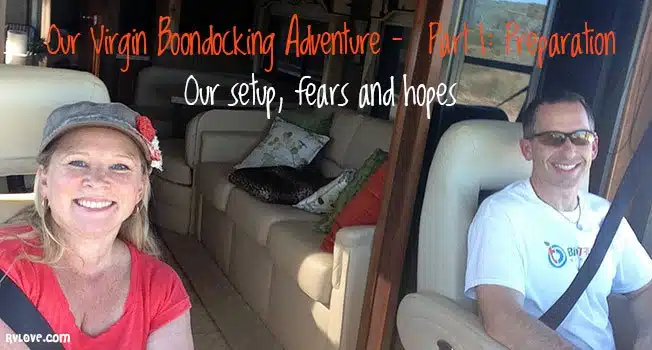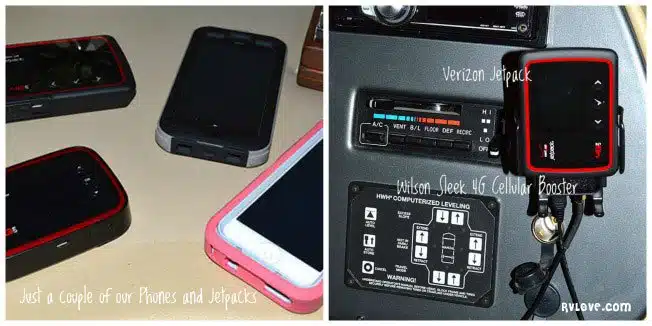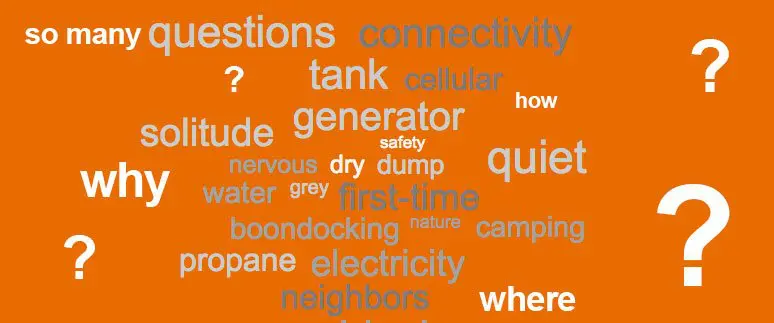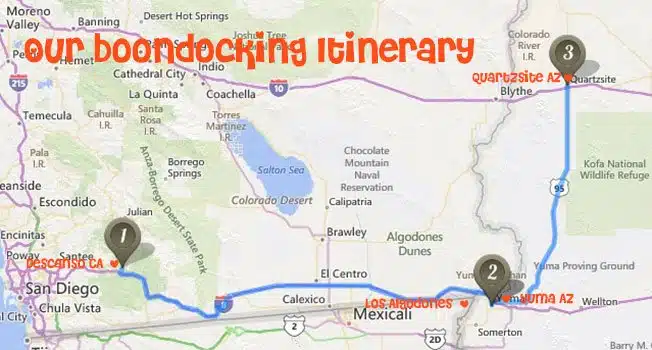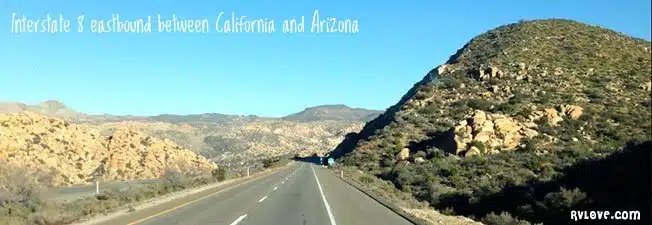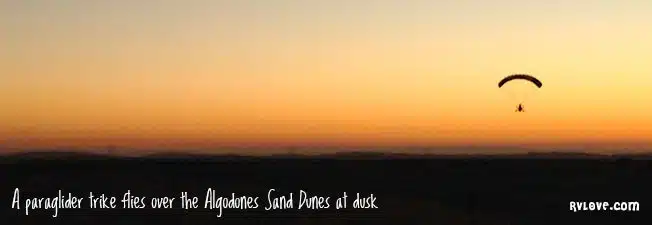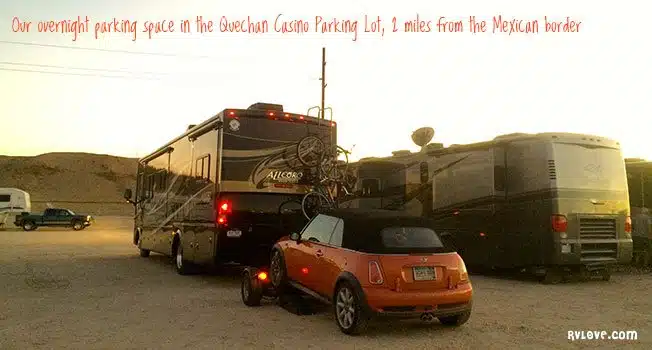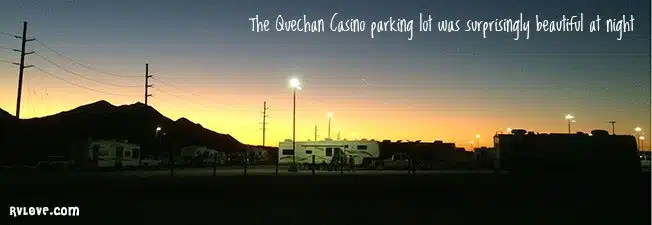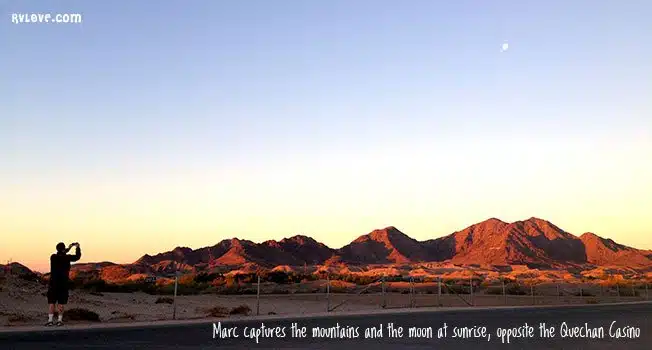This post may contain affiliate links.
After 8 months on the road staying mostly in campgrounds with full hook-ups (electricity, water and sewer) we decided it was time to mix things up and try a stint of boondocking. Also known as dry camping, free camping or wild camping, boondocking is basically camping without hook-ups. The idea of being able to camp “off-the-grid” (OTG), immerse ourselves fully into a natural environment and live in a self-sufficient manner – without relying on public utilities – held a unique kind of appeal. We figured we’d find some more solitude, save on campground fees and were curious about how we would cope equipped with only the resources we had on board.
The concept was simultaneously scary and liberating. I wondered – would it be exaggerating to call it our “RVLove Survivor” adventure series? Hmmm, probably so 🙂
Now, aside from the occasional overnighter in a parking lot at Walmart, Cracker Barrel or truck stop along our route after a long day of driving, we hadn’t done any real boondocking. We had read about and even met a few people who do boondock regularly, but most of them had solar panels and seemed like they were pretty well equipped for longer stays.
We don’t have solar, so we would have to rely on our generator for power and we had no absolutely no clue as to how long our fresh water tank would last us, so what better way to find out than give it a try! 🙂
Admittedly, as first-timers – boondocking virgins – we had no idea how we’d go with it, and were a tad nervous about how this might go down. In truth Marc was pretty comfortable, I was the nervous one! After agreeing on a backup plan (ie. if I/we hated it, we would simply check into the nearest campground) we began preparing for our boondocking “adventcha”!
Our top 3 priorities were:
i) power – being able to charge/use our phones and computers
ii) strong cellular coverage – to stay connected via our WIFI hotspots and phones (see How Technology Keeps us Mobile for our original set up). Or check out our most recent post on the what we use now for our Best RV Internet solution here.
iii) water – of course!
In his quest to tackle our biggest questions, Marc started researching what was possible with what we already had in our coach. Many RVs these days are designed to be pretty self contained and self-sufficient. Fortunately, our motorhome is a newer model (2012) so it already had a lot of great features that are not only meant to make boondocking possible, but actually quite comfortable.
Our RV equipment setup
Our motorhome is a 2012 Tiffin Allegro Open Road gas coach and was already well equipped with:
- 7000 watt Generator – this provides us with electrical power. 7,000 watts is a very decent size for a generator, in fact ours provides us with even more power than a 30amp campsite, which allows us to run both air conditioners at the same time, if we need to. It also allows us to run our computers, microwave, TV etc (though we rarely watch TV or use the microwave)
- 2 x 6 volt deep cycle house batteries – provides power for our lights, fans and furnace when the generator isn’t running (our main house lights are LED)
- 24 gallon propane tank – keeps the fridge/freezer running (when generator is off), provides furnace heat and ability to cook using range-top and oven
- 70 gallon fresh water tank – for drinking, showering, washing dishes etc
- 75 gallon fuel tank – for driving and powering the generator
- 65 gallon grey tank – collects the dirty shower and sink water
- 50 gallon black tank – collects toilet waste
Other useful items which we already had on board included:
- Wilson Sleek 4G Booster – signal booster that boosts our voice and data signal for our cell phones and WIFI hotspots
- Portable inverter/charger – this converts DC battery power into AC regular power to enable charging of phones and other small electronics (without generator)
- Portable Weber BBQ with 5 gallon propane tank – for outdoor cooking
We were off to a good start! It was exciting for us to realize that we didn’t need to spend any extra money on fancy gadgets or equipment to be able to boondock. Marc was actually pretty confident with our “off-the-grid” systems as he knew all about the ‘power and tank stuff’. I was the one most nervous about being under-equipped as until we started full-timing, this whole camping thing was all very new to me. I’d read a lot about experienced boondockers who have a pretty snazzy setup with things like solar panels for power and a composting toilet for handling their ‘business’. While these may be great additions to consider down the road (pun intended), we were relieved to realize they certainly weren’t essential items for people like us just getting started.
Our fears and concerns
While plenty of blogs and articles share boondocking tips and advice, I didn’t find many that covered the range of questions, fears and concerns that might arise for a newbie! From Marc’s concerns about how long I would spend in the shower using up our valuable water supply to my concerns about whether I’d be able to get all of my work done on my iMac before Marc wanted to shut down the generator (my laptop is so old it won’t even run on battery anymore), this list will give you a sense of what was running through our heads:
- How and where would we find a suitable place to park – legally? Would we be woken in the middle of the night and be asked to leave or handed a fine?
- What would the road surface be like? Would it be too rough and rugged and cause damage to our coach or Mini? Would it be soft and cause us to sink in the sand?
- Would we have sufficient internet/cellular coverage to effectively work during the week?
- Where would we fill our water tank? (Driving with a full water tank would be too much weight in the coach and also increase fuel consumption)
- Would it feel lonely, isolated or even unsafe? Or would it be crowded with other rigs?
- Would it be too hot? Would it be too cold?
- What would it cost to run the generator each day to power the coach? Would it be expensive?
- Would my Apple iMac desktop work OK on the generator power?
- Where would we dump our black and grey tanks? How much would that cost?
- How far away would we be from services and shops for groceries?
- How long would our fresh water last us? Would we have enough water to last the entire time without having to break camp and refill?
- How much would we have to modify our day-to-day activities to live comfortably?
- How noisy would the generator be? Would we find a space far enough away from our neighbors to run the generator without bothering them?
- Will it be dirty and dusty and make a mess of the coach? Will I have to spend hours cleaning it all up afterward?
- What will the average cost per night be compared with a campground, specifically our Thousand Trails camping membership?
- Can we really do this? Will we like it? Will we hate it!?
- And, will we still love each other at the end of it!? (OK, just kidding about that one)
Now you can start to get a sense of our (my) initial trepidation. Changing an environment and reducing predictability can increase stressors, yet we both knew the only way to truly get the answers was to go for it and learn through firsthand experience! After all, no matter how much research we did, we noticed everyone’s setup, needs and usage was very different. We needed to find out what would work for US.
Our hopes and goals
We were really looking forward to a completely new and different experience to what we’d been used to in the campgrounds – here’s what we were hoping for:
- Mixing things up and trying something entirely new, stretching us out of our comfort zones
- Finding an ideal, peaceful, spacious spot with a beautiful view and environment
- Increasing our connection with nature and spending the evenings gazing up into a black sky filled with bright stars
- Feeling liberated and empowered by our options for living off-the-grid– whether by choice or during times of power or water outage
- Discovering how affordable it really is, potentially opening up a new range of opportunities, possibilities and variety for future camping
- Enjoying more freedom and flexibility while feeling a greater sense of self-sufficiency and independence
- Building our confidence in doing more boondocking in the future, especially in the states where our Thousand Trails membership has no campgrounds
- Having a whole new experience – one that is expansive, memorable and fun!
Next, it was time to think about location, location, location!
Where to go – planning ahead and finding boondocking locations
Marc began researching potential boondocking locations within a reasonable driving distance of our starting point of Descanso, just east of San Diego, CA. After scouring the websites of a few of our favorite full-time RVers for recommendations, we decided to split our time between Yuma and Quartzsite in Arizona, both popular winter destinations for snowbirds who flock to the southwest in search of sunshine, a warm, dry climate and an abundance of free or cheap places to boondock.
Snowbirds are people from the US Northeast, US Midwest, Pacific Northwest or Canada who spend a large part of winter in warmer locales such as California, Arizona, Florida, Texas or elsewhere along the Sun Belt of the southern and southwest United States, Mexico and areas of the Caribbean.
There’s an abundance of free boondocking areas – mostly BLM Land – available in both Yuma and Quartzsite. Marc identified a specific area to park in Yuma, based on reports of strong cell coverage. For Quartzsite, we figured we’d just wing it and find a place park on the day of arrival as we knew there’d be loads to choose from!
Did you know? One eighth of all USA land is publicly owned, and is administered by the Bureau of Land Management. Commonly known as BLM Land, much of it is available to the public to camp for free – typically up to 14 days – although you may be able to stay longer for a fee.
So, with our destinations – Yuma and Quartzsite – decided upon, we hit the road after work on a Friday afternoon and headed east for our 8 days and 9 nights of boondocking in the desert! With so much to cover – our experiences, insights and learnings – we decided to share them in a little series of blog posts for easier reading.
Day 1: A change of plans already and casino camping in Yuma, AZ
It was a ruggedly beautiful drive east bound as along Interstate 8, which runs pretty much parallel to the Mexican border. While traveling along one section, we were so close to Mexico that my cell phone carrier sent me a text message welcoming me abroad! Soon, the landscape changed from mountains to desert and sand dunes, where we saw a trike paraglider flying over the Algodones dunes. Beautiful!
We had hoped to get to Yuma before sundown and find our camp spot for our first week off the grid while we still had light. As so often happens with the coach, things took a bit longer than expected and we were still driving at dusk. Even though we were close to our destination, rather than try and find a spot in an unknown environment in the dark, we quickly modified our plans and decided to spend the first night in a casino parking lot. A quick search on the iPhone led us to the Casino Camper website which revealed the Quechan Casino Resort welcomed RVers and truckers alike, with loads of free parking in their level dirt lot. We called ahead to check on their policy, obtained their permission to park overnight and pulled into the parking lot just around sunset. It was surprising to see just how many other RVs and trucks were already there – at a quick count we estimate there were well over 100!
This diversion turned out to be a really fun twist to our plans as we were still driving around the lot looking for a good place to park when a group of Canadians called out for us to pull up next door and join them for a drink! We had a fun chat with them – Canadians are so darn nice and friendly! – listened to their stories and next thing you know, they are inviting us to join them for the Winter Blast fireworks show in Lake Havasu City the following weekend, camping on BLM Land. Why not? We were up for anything! It was only the first night of our boondocking adventure and we were already deciding to cut our Quartzsite stay short so we could fit in Lake Havasu as well – it was shaping up to be a fun week for sure. With phone numbers exchanged, we said our goodbyes then headed into the Quechan Casino for dinner.
Casino Camping
Many casinos welcome RVers and truckers to dry camp in their parking lots (well away from cars) as it brings extra patrons into the casino, to spend money on food, drinks and gambling! Because you’re getting a ‘free’ night’s stay on their property, it’s considered good etiquette to go inside the casino and utilize their services. That said, depending on your eating, drinking and gambling habits, it could also end up costing you way more than a night at a campground with full hook-ups! But as we’re neither big drinkers nor gamblers, we were able to just enjoy a meal in their cafe. Casino eateries tend to be pretty reasonably priced as that’s how they get you inside! We headed back to the coach for an early night in readiness for our big week of boondocking adventures ahead, including our first trip to Los Algodones, Mexico for dental work! Time to get some zzzzzzzz’s!
Read more in Part 2: Yuma, Arizona
Read more in Part 3: Quartzsite, Arizona

